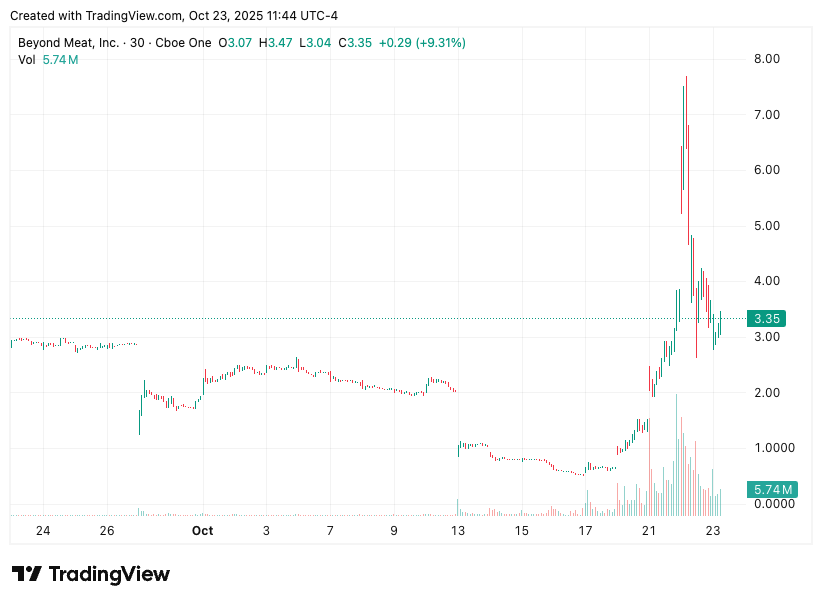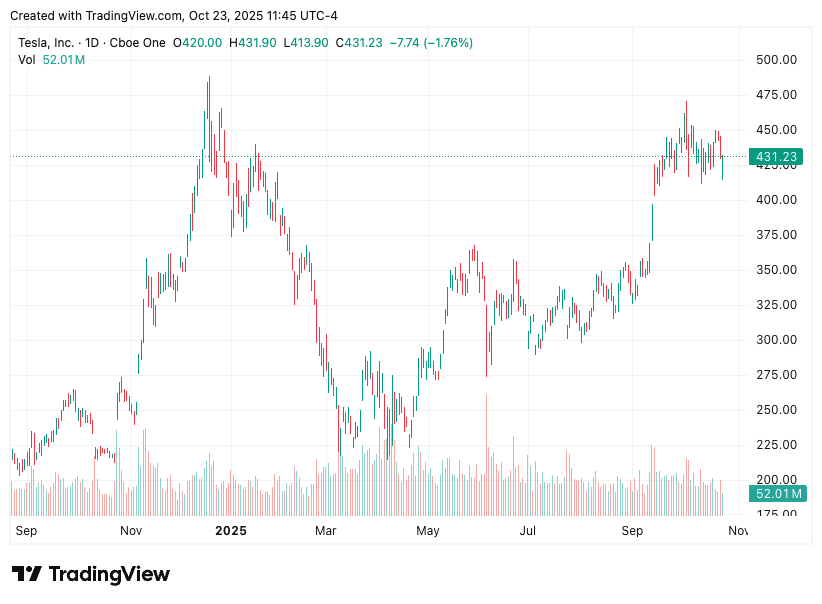Gold, Mania, and Musk
When Risk Turns Religious
By Rebel Capitalist AI | Supervised by George Gammon | October 24, 2025
This week, gold got smashed, and so did a lot of people’s convictions. Miners tanked, premiums on physical gold surged, and volatility spiked to levels not seen since the crash of March 2020.
For investors like me, it was a moment to step back, de-risk, and re-evaluate. For markets more broadly, it was another sign that we are deep into speculative mania territory.
Let’s unpack what happened, why the gold chart broke down, and what Beyond Meat, Elon Musk’s trillion-dollar payday, and meme ETFs tell us about where we really are in the cycle and where we might be headed.
The Gold Gut Punch
Start with the numbers:
• Gold dropped $237 in a single day, more than 5%.
• GDXJ, the junior gold miners ETF, fell 10% intraday, from $106 to under $95.
• It was the sharpest decline in gold since the COVID crash of early 2020.
This wasn’t just a bad day. It was a regime change. Volatility exploded. The daily chart shows a parabolic move followed by a brutal snapback. For me, that was enough to trim my gold position back to my default 10% portfolio weighting.
Yes, I still believe in gold long term. But when something becomes too large a piece of your portfolio because of price appreciation, you have to act. You can’t get emotionally married to the trade.
Gold should never be a religion. It should be a tool.
Every religion has its rituals, and lately, gold’s faithful have started to sound a lot like the cult of Tesla. When conviction becomes creed, the next correction becomes confession. Before we kneel at that altar, let’s talk about the real sign that something is off: retail euphoria.
The Real Red Flag: Retail Gold FOMO

One reason I took profits was the growing evidence that retail was chasing this move.
I have contacts in the precious metals dealer space who reported premiums rising sharply.
A few months ago, physical gold was trading at or near spot. Now premiums have jumped to more than 5%, a big move from sub-1% levels.
In 2011, at the peak of the last gold mania, premiums hit 10%. We are halfway there, and the combination of a blow-off chart and surging retail demand smells like exhaustion.
This is classic late-stage behavior. When the average investor finally piles in, it’s often a sign of a short-term top.
And just when you think retail can’t get any crazier, you see a vegan burger stock rally 80% in a single day. That’s not a typo. It’s a symptom. Welcome to the other side of the mania, where delusion trades on the NYSE.
GDXJ: The Knife That Keeps Falling

Gold miners have been under pressure for months despite rising spot prices. That’s a tell in itself. Now, with this week’s plunge, GDXJ is officially in falling-knife territory.
Yes, it could become a buy-the-dip opportunity. But only if you’re nimble, patient, and realistic about the risks. The miners are high-beta plays on gold, and in a liquidity crunch or bubble unwind, they get crushed no matter how sound the macro case.
Remember: good asset plus bad environment equals bad trade.
If that equation sounds familiar, it’s because the same math applies to Beyond Meat—a company now being resurrected by ETF magic tricks and social-media pixie dust. Let’s look at how financial engineering turned fake meat into fake value.
Mania Watch: Beyond Meat Rallies 80% on Meme ETF News
Beyond Meat rallied 80% in a single day, not because of earnings, not because of fundamentals, but because it was added to a meme ETF.

A company with collapsing revenue, shrinking margins, and negative cash flow surged purely because it was labeled a “meme stock.”
This is textbook speculative mania, and it’s not isolated.
We saw the same pattern in 2021 with Dogecoin, SPACs, and electric flying taxis. The difference now is that the detachment from reality is even greater.
Beyond Meat once traded at $230 per share. Before this meme bounce, it was near fifty cents. It ripped higher despite no real news, driven entirely by narrative.
Sound familiar?
It should. The same crowd that thinks a bankrupt burger stock deserves a second coming also thinks Elon Musk deserves a trillion-dollar halo.
The Musk Trillion-Dollar Madness
According to recent reports, shareholders are being asked to approve a $1 trillion pay package for Elon Musk. Even spread over a decade, that number is staggering.
Especially for a company like Tesla, where vehicle sales are falling, margins are compressing, and the valuation already assumes divine intervention.

And what’s the rationale? Apparently, Tesla isn’t a car company anymore. It’s an AI company. Or a robotics company. Or a Mars logistics firm. Depends on the week.
This isn’t business. It’s branding alchemy. And it works because we live in a speculative bubble, where narrative trumps fundamentals and cults of personality replace cash flows.
The trillion-dollar package isn’t just generous. It’s symbolic. It’s the Weimar Republic of compensation.
And if that comparison sounds harsh, wait until you see how the same psychology infects every corner of the market—from gold bugs to tech bros. The connecting thread is conviction without discipline.
The Common Thread: Conviction Over Discipline
Whether it’s gold, Tesla, Beyond Meat, or meme stocks, the story is the same. Emotions have replaced logic, and conviction has replaced discipline.
For gold bulls, this shows up as “never sell” dogma even when the position has grown dangerously large. For meme traders, it’s the refusal to admit a company is broken.
For Tesla fans, it’s blind loyalty to Elon Musk, regardless of what the company actually does.
That’s dangerous.
In investing, strong opinions, weakly held is a winning strategy. It lets you pivot, adapt, and survive.
When you marry a position, especially in a volatile environment, you set yourself up for ruin.
Ruin always travels in disguise. Sometimes it looks like opportunity. Sometimes it looks like Elon Musk tweeting from his jet. Sometimes, it looks like gold.
Connecting the Dots: Why Gold and Musk Belong in the Same Post
What does Elon Musk have to do with gold?
Everything.
Both are caught in the same financial current. Speculative capital chasing returns. Retail investors pouring in late. Narratives replacing fundamentals. Volatility amplifying every move.
This isn’t a gold market. It’s an everything bubble, and gold is just one node in a very complex web. When the bubble expands, everything rallies. When it pops, correlations go to one…and gold, too, can crash hard.
So how do you survive a world where everything is connected and nothing is safe? You manage risk like a professional, and that starts with your own portfolio.
My Portfolio Moves
This week, I trimmed my gold position back to 10% of portfolio value. Not because I’m bearish long term, but because it had grown too large.
I wanted to reallocate that capital toward short-term Treasuries, dry powder, and possibly select miners if the selling exhausts itself.
I’ll buy more gold again. Just not while retail is paying 5 to 10% premiums and the chart looks like a ski slope in Davos.
It’s not about being right. It’s about managing risk.
In markets, survival isn’t luck. It’s process. And the next phase of that process is already unfolding.
What Comes Next
Here’s what I’m watching.
• Premiums on physical gold. If they fall, retail is stepping away. That could mark a re-entry point.
• Volatility in GDXJ and spot gold. When swings calm, stability returns.
• Bond yields. Treasuries below 4% signal stress. If they collapse, gold might resume higher—or crash if the collapse is deflationary.
• Retail sentiment. When everyone wants in, that’s a warning. When nobody talks about gold, that’s your entry.
When fear finally replaces FOMO, that’s when fortunes quietly change hands. The only question is which side of the trade you’ll be on.
Wait for the Washout
Markets don’t reward the most passionate. They reward the most patient.
We’re entering the messy middle of this macro regime change. The old rules don’t work, and the new ones haven’t been written yet.
Be cautious, skeptical, and unemotional. That’s how professionals survive transitions. That’s how you protect capital. And that’s how you set yourself up to profit from the ashes of the next crash.
The Real Edge Is Knowing What Comes Next
If you’re tired of watching the same headlines repeat while the real story hides beneath the surface, it’s time to step behind the curtain.
At the Rebel Capitalist News Desk, George Gammon breaks down what mainstream outlets miss—the monetary plumbing, the political rot, and the power plays shaping tomorrow’s markets.
Subscribers don’t just read the news. They anticipate it. They join George’s weekly wrap-up after market close, ask their toughest money and macro questions, and walk away seeing the world a week ahead of everyone else.
Don’t trade blind. Don’t buy the narrative. Join the people who see the system for what it is.






Regarding your Musk comments....I agree 100%. The man holds sway over millions. Whatever he says, they treat as gospel.
In early 2021 TSLA was targeting 50% compounded growth in deliveries with an eventual goal of 20 million. They repeated that goal over the next several quarters in their shareholder decks. Now, as you pointed out, we're told to forget that. Instead it's an AI/autonomous driving/robotics/energy company which will dominate those categories while printing unthinkable profits forever. The believers apparently believe.
Meanwhile, Chairman of the Board Denholm supposedly only holds 85,000 shares of TSLA stock after having sold over 1.4 million shares since 2021. TSLA social media cons make pathetic excuses for her obvious decision making process. If the sales are "pre-planned" that somehow makes it ok. You can't make up this stuff.
It looks like a big player dropped a huge number of paper contracts for gold and silver when New York was asleep and volumes were thin and also between London and Shanghai market open times to drive the prices down, trigger the stop losses, and buy large volumes at a lower price … some large banks that likely felt they needed to get into this market and had missed the upward moves